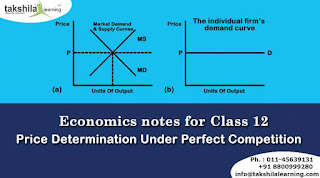Economics class 12 - Price Determination Under Perfect Competition
Takshila Learning offers online/offline coaching for Class 11 to 12th to the students so that they can easily score good marks in CBSE exams.
Economics notes class 12: Perfect competition market refers to a market situation where a large number of buyers and sellers are dealing in a homogeneous product.
Also, there are no legal, social or technological barriers on the entry and exit of any firm. It means that any firm is free to enter the market when finds it profitable and can leave it when wishes to do so.
Under the perfect competition market, the industry is the price maker and the firm is the price taker. It means that the price of the goods and the services are determined by the industry and they are accepted by the individual firms.
A FIRM is a producing unit which produces goods and services with the motive of earning profit through its sale.
An INDUSTRY is an aggregate of all the firms producing the same commodity. Alternatively, all the firms producing and selling the same product are collectively known as an industry.
Full article read here ..... Price Determination Under Perfect Competition
We, Takshila Learning offer the best online classes for Economics Class 12. With the increase in the use of technology in our day to day lives, we have also designed an online course along with notes which cater to all your needs in preparing board exams. You can watch our videos anywhere at any time taught by our best-experienced faculty. You can attempt our CBSE Class 12 Economics classes with a detailed explanation, analysis of the exam and much more. We also provide notes, sample papers, different blogs, and articles on important topics, and information related to board examination. Today from our Microeconomics Class 12 section, I have chosen the following topic ‘Exceptions to the law of demand’ from NCERT Economics Class 12.
We, Takshila Learning offer the best online classes for Economics Class 12. With the increase in the use of technology in our day to day lives, we have also designed an online course along with notes which cater to all your needs in preparing board exams. You can watch our videos anywhere at any time taught by our best-experienced faculty. You can attempt our CBSE Class 12 Economics classes with a detailed explanation, analysis of the exam and much more. We also provide notes, sample papers, different blogs, and articles on important topics, and information related to board examination. Today from our Microeconomics Class 12 section, I have chosen the following topic ‘Exceptions to the law of demand’ from NCERT Economics Class 12.

Comments
Post a Comment
Thank you we will contact ASAP.